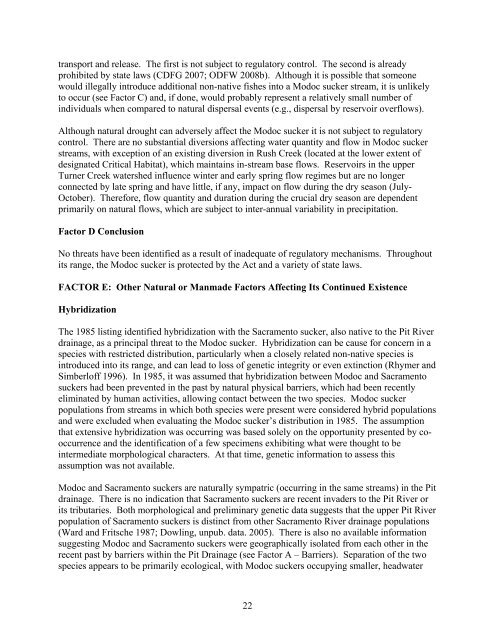Modoc sucker - U.S. Fish and Wildlife Service
Modoc sucker - U.S. Fish and Wildlife Service
Modoc sucker - U.S. Fish and Wildlife Service
Create successful ePaper yourself
Turn your PDF publications into a flip-book with our unique Google optimized e-Paper software.
transport <strong>and</strong> release. The first is not subject to regulatory control. The second is already<br />
prohibited by state laws (CDFG 2007; ODFW 2008b). Although it is possible that someone<br />
would illegally introduce additional non-native fishes into a <strong>Modoc</strong> <strong>sucker</strong> stream, it is unlikely<br />
to occur (see Factor C) <strong>and</strong>, if done, would probably represent a relatively small number of<br />
individuals when compared to natural dispersal events (e.g., dispersal by reservoir overflows).<br />
Although natural drought can adversely affect the <strong>Modoc</strong> <strong>sucker</strong> it is not subject to regulatory<br />
control. There are no substantial diversions affecting water quantity <strong>and</strong> flow in <strong>Modoc</strong> <strong>sucker</strong><br />
streams, with exception of an existing diversion in Rush Creek (located at the lower extent of<br />
designated Critical Habitat), which maintains in-stream base flows. Reservoirs in the upper<br />
Turner Creek watershed influence winter <strong>and</strong> early spring flow regimes but are no longer<br />
connected by late spring <strong>and</strong> have little, if any, impact on flow during the dry season (July-<br />
October). Therefore, flow quantity <strong>and</strong> duration during the crucial dry season are dependent<br />
primarily on natural flows, which are subject to inter-annual variability in precipitation.<br />
Factor D Conclusion<br />
No threats have been identified as a result of inadequate of regulatory mechanisms. Throughout<br />
its range, the <strong>Modoc</strong> <strong>sucker</strong> is protected by the Act <strong>and</strong> a variety of state laws.<br />
FACTOR E: Other Natural or Manmade Factors Affecting Its Continued Existence<br />
Hybridization<br />
The 1985 listing identified hybridization with the Sacramento <strong>sucker</strong>, also native to the Pit River<br />
drainage, as a principal threat to the <strong>Modoc</strong> <strong>sucker</strong>. Hybridization can be cause for concern in a<br />
species with restricted distribution, particularly when a closely related non-native species is<br />
introduced into its range, <strong>and</strong> can lead to loss of genetic integrity or even extinction (Rhymer <strong>and</strong><br />
Simberloff 1996). In 1985, it was assumed that hybridization between <strong>Modoc</strong> <strong>and</strong> Sacramento<br />
<strong>sucker</strong>s had been prevented in the past by natural physical barriers, which had been recently<br />
eliminated by human activities, allowing contact between the two species. <strong>Modoc</strong> <strong>sucker</strong><br />
populations from streams in which both species were present were considered hybrid populations<br />
<strong>and</strong> were excluded when evaluating the <strong>Modoc</strong> <strong>sucker</strong>’s distribution in 1985. The assumption<br />
that extensive hybridization was occurring was based solely on the opportunity presented by cooccurrence<br />
<strong>and</strong> the identification of a few specimens exhibiting what were thought to be<br />
intermediate morphological characters. At that time, genetic information to assess this<br />
assumption was not available.<br />
<strong>Modoc</strong> <strong>and</strong> Sacramento <strong>sucker</strong>s are naturally sympatric (occurring in the same streams) in the Pit<br />
drainage. There is no indication that Sacramento <strong>sucker</strong>s are recent invaders to the Pit River or<br />
its tributaries. Both morphological <strong>and</strong> preliminary genetic data suggests that the upper Pit River<br />
population of Sacramento <strong>sucker</strong>s is distinct from other Sacramento River drainage populations<br />
(Ward <strong>and</strong> Fritsche 1987; Dowling, unpub. data. 2005). There is also no available information<br />
suggesting <strong>Modoc</strong> <strong>and</strong> Sacramento <strong>sucker</strong>s were geographically isolated from each other in the<br />
recent past by barriers within the Pit Drainage (see Factor A – Barriers). Separation of the two<br />
species appears to be primarily ecological, with <strong>Modoc</strong> <strong>sucker</strong>s occupying smaller, headwater<br />
22

















